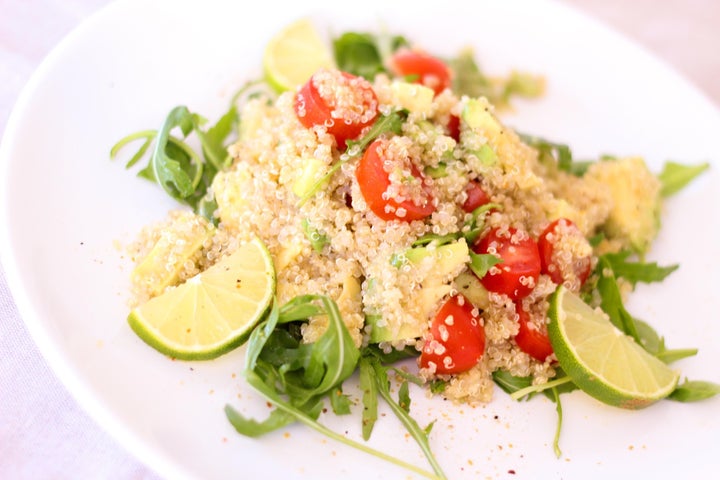
September is back to school time and the start of the fall season. It is also Whole Grains Month and there’s lots of reason to celebrate. Including whole grains in your diet is a great way to boost nutrient intake. Whole grains are packed with vitamins and minerals including folate, vitamin E, magnesium, selenium, and protective phytonutrients. Research shows that eating whole grains instead of refined grains lowers the risk of chronic diseases, including heart disease, stroke, Type 2 diabetes, hypertension, and certain cancers.
Including whole grains in your diet can also help with weight loss despite the Paleo movement and low-carb enthusiasts who shun even the healthiest of grains. Whole grains are actually relatively low in calories (approximately 80-100 calories per ½ cup serving) and are also rich in fiber which helps you feel full (and, therefore, stop eating!)
Despite the health benefits of whole grains, and the recommendations to eat at least half of your grains as whole grains (3 whole grain servings daily for a 2000 calorie diet), most Americans eat fewer than one serving per day. And, instead, we fill up on refined grains (yes, white bread products) which are devoid of fiber and other important nutrients.
Next time you decide which starchy carbohydrate to eat, I suggest you skip the white pasta and white rice and include healthy grains instead: brown rice, amaranth, quinoa, kasha, farro, whole corn, millet, whole wheat pasta, and kamut to name a few. If you happen to be following a gluten-free diet, no problem, as many terrific and versatile grains are now readily available on the market.
These healthy and tasty whole grains are worth placing at the top of your shopping list.
Quinoa
Quinoa, technically a seed and not a grain, is a nutrition treasure and has a protein content that is superior to that of most grains, because it contains all the essential amino acids. It is high in the amino acid lysine, which is important for tissue growth and repair. It is also rich in the minerals iron, magnesium, manganese, phosphorus and copper, and a great choice if you are eating a gluten-free diet. Quinoa is also high in the antioxidants quercetin and kaempferol which are thought to protect against a range of chronic diseases. And it contains 5 grams of fiber per one cup serving. It is also versatile and can be added to salads, veggie burgers and chili.
Buckwheat
Buckwheat brought to America by Russian and Polish immigrants who called it “kasha,” is a good source of the minerals manganese, magnesium, and zinc, as well as flavonoids like quercetin and rutin, which contain antioxidant and anti-inflammatory properties. A great choice for those following a gluten-free diet, one cup of cooked kasha contains five grams of fiber.
Growing up, my grandmother used to make kasha varnishkes — kasha, bow tie noodles, onions and fat. This version is not gluten free unless you use gluten free noodles. Unless it’s a nostalgic occasion, for a healthier version, I suggest sticking with the kasha and skipping the bow tie noodles.
Whole corn
Fresh corn on the cob. Popcorn. Corn cakes. Polenta. Yes, corn is a whole grain and can be extremely healthy for you when it's whole. A good source of B vitamins, magnesium, and phosphorus, whole corn is high in fiber and gluten free. Contrary to popular belief, whole corn is not high in calories; a corn on the cob contains around 100 calories. Yellow corn is also high in antioxidants. One of my summer favorites: fresh corn on the cob from the Farmer’s market.
Oats
Enjoying oatmeal for breakfast is one of the most common ways to eat oats. Not only does it taste delicious, it is also filling, chock full of fiber, and lower in calories and sugar than many breakfast cereals. Oat bran is particularly high in the soluble fiber β-glucan which has been shown to reduce cholesterol levels, making it a great choice to prevent heart disease. Oats also contains magnesium and potassium, two minerals also good for your heart.
Farro
Farro is an ancient wheat grain that originated in Mesopotamia. Though we refer to farro as if it were one just grain, the term is Italian for "ancient wheat grain" and is often used to describe three different grains: farro piccolo (einkorn), farro medio (emmer), and farro grande (spelt). Emmer wheat is the kind that is most commonly found in the U.S and Europe and it is sometimes confused with spelt, an entirely different type of grain.
Farro has a nutty flavor and a chewy texture and is a healthy alternative to popular grains, such as rice and quinoa. It is yummy as an ingredient in stews, salads and soups. It is very nutritious, rich in protein and fiber, magnesium, zinc, B vitamins, and antioxidants. Best to choose whole farro as opposed to the pearled variety.
Next time you have the urge to include refined white products at your next meal or skip the grain family altogether, think again and include these super foods on your plate. Here’s your permission slip to eat more carbs…the healthy way.
Want recipes, tips, and ideas on how to prepare whole grains? We’ve got you covered.
The Oldways Whole Grain Council (WGC) offers recipes and tip sheets on preparing whole grains.
No time to cook? No problem! My nutrition colleague, Ellie Krieger, award winning author, and producer and host of the cooking series “Ellie’s Real Good Food”, rounds up some new products that make whole grains a cinch to prepare.
Want to wake up with whole grains tomorrow morning? This expert roundup (me included) offers unique and novel ways to incorporate whole grains in to your breakfast routine.
Here’s to a healthy fall.
